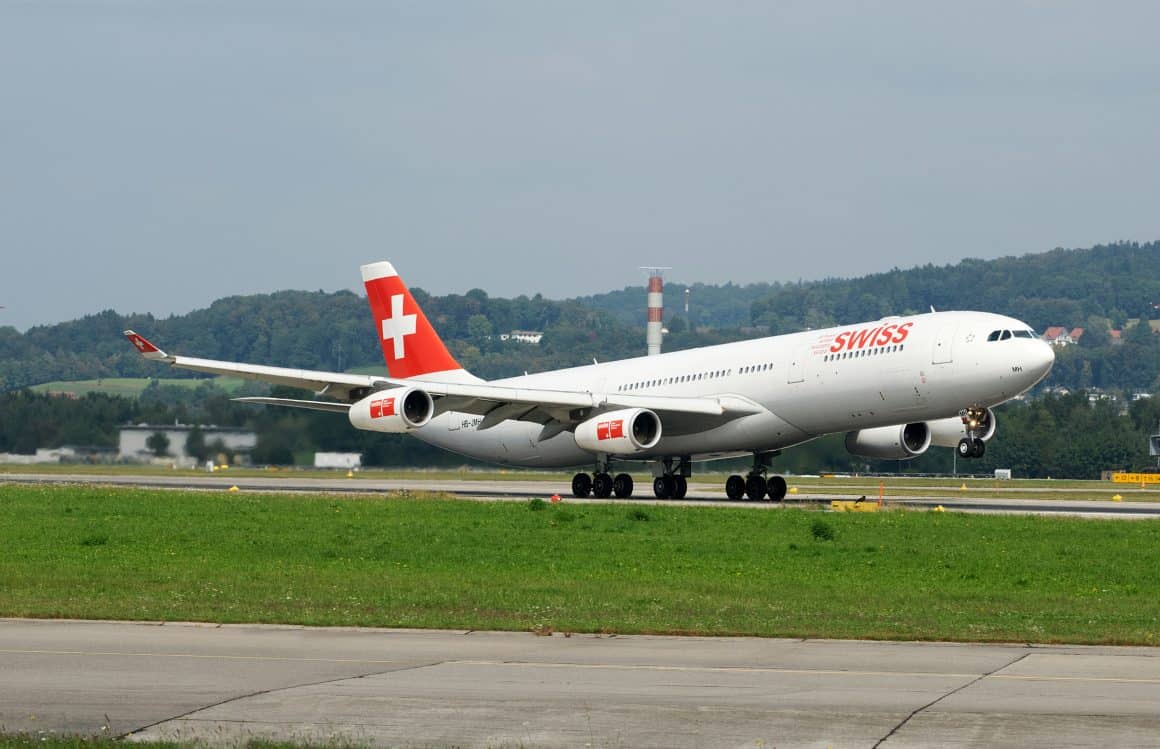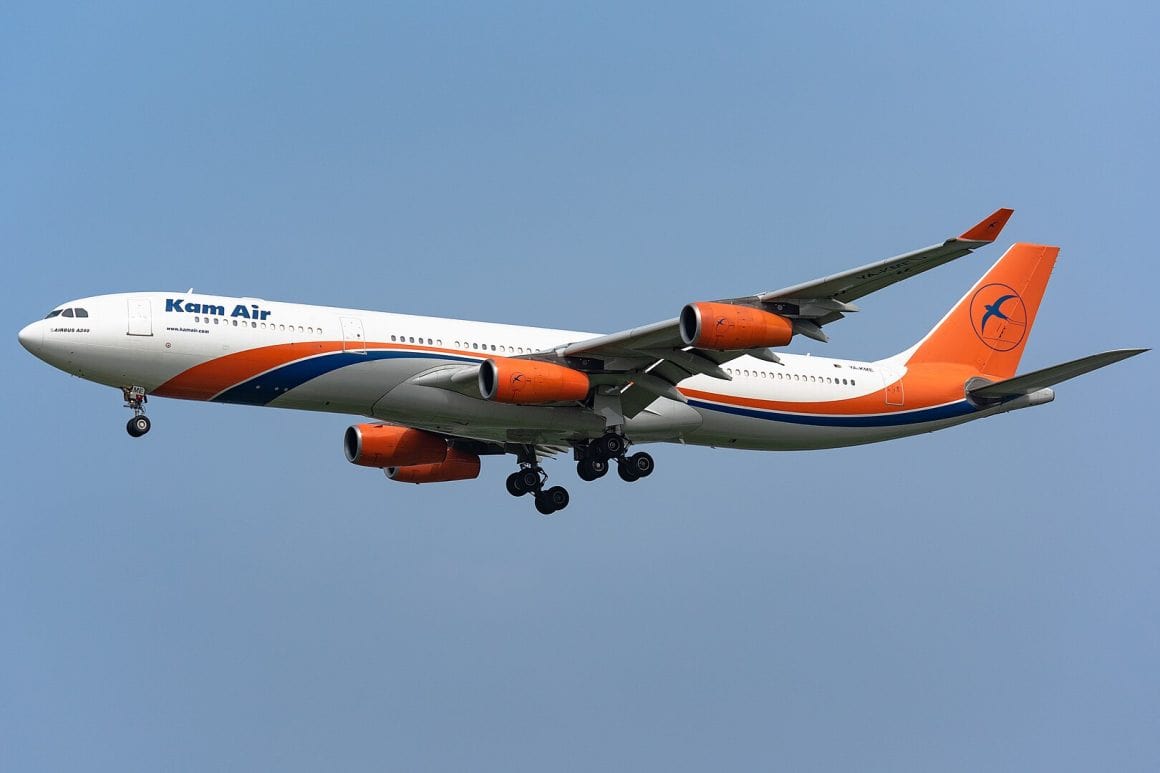Once a staple of long-haul travel and a symbol of Airbus’ ambition to rival Boeing’s widebodies, the four-engine Airbus A340 is now a rarity in commercial service. But it hasn’t vanished.
As of May 2025, 49 A340s remain in scheduled passenger service across seven airlines. Another 28 are still flying in various roles—including charters, VIP transport, government flights, and ACMI operations—bringing the total number of active A340s to 77. An additional 38 airframes are inactive but not necessarily permanently; they’re either in storage or undergoing maintenance and could fly again.
77 (115 if you include inactive units) may not sound like much, especially considering that 377 A340s were built, but the aircraft still turns heads wherever it lands. With the recent announcement that Lufthansa will swap out the A330-300 for the A340-300 on its Frankfurt (FRA) to Raleigh-Durham (RDU) route this upcoming winter, we thought it was a good time to check in on where the aging quadjet is still flying today.
The A340 Legacy: A Quadjet’s Quiet Exit

The Airbus A340 was developed to compete with the Boeing 777 and McDonnell Douglas MD-11, debuting with the -200 and -300 variants in 1993. As Airbus’ first long-haul twin-aisle aircraft, it was designed for high-capacity, ultra-long-haul routes in a pre-ETOPS era when four engines were preferred for transoceanic flights.
The -200, with 261 seats and an 8,100 NM range, and the -300, seating 295 with a 7,300 NM range, entered service in March 1993 with launch customers Lufthansa and Air France. The -300’s maiden flight was on 25 October 1991, and both variants were certified in December 1992. Both the -200 and -300 are powered by CFM56-5C engines.
The larger -500 and -600 variants followed in the early 2000s. The -500, with 313 seats and a 9,000 NM range, first flew on 11 February 2002 and entered service in 2003 with Emirates after Air Canada, the intended launch customer, filed for bankruptcy. The -600, seating 379 with a 7,800 NM range, flew its maiden flight on 23 April 2001 and entered service with Virgin Atlantic in August 2002. At 247 feet 5 inches, the -600 was the world’s longest passenger aircraft until the Boeing 747-8 debuted in 2010. The latter two variants are powered by larger, more powerful Rolls-Royce Trent 500 engines.
However, the rise of ETOPS and more fuel-efficient twinjets made the A340 less competitive. Airbus ended production in November 2011 after delivering 377 of the 380 ordered A340s from its Toulouse factory, with the final two -500s delivered in 2012. The A340’s successor, the A350, now dominates long-haul routes.
Despite its commercial decline, the A340 has a strong safety record, with no fatal accidents but six hull losses, including Air France Flight 358, an A340-313 that overran the runway during a thunderstorm at Toronto Pearson International Airport (YYZ) in August 2005.
Who Still Flies the Airbus A340?

According to data, as of May 2025, only seven airlines continue to operate 49 Airbus A340s on scheduled commercial flights. Here’s a breakdown.
- Lufthansa (Germany): The largest A340 operator with 22 active aircraft (16 A340-300s, 6 A340-600s) out of a fleet of 23, Lufthansa was the launch customer for the -200 in 1993 and once operated 62 of the type. The airline uses the type on long-haul routes to US destinations like Boston (BOS), Chicago (ORD), Dallas/Fort Worth (DFW), Detroit (DTW), Los Angeles (LAX), New York (JFK), Seattle (SEA), and Washington Dulles (IAD). Chicago is the only US city with scheduled A340-600 service, with two daily flights from Frankfurt—one on the A340-600 and another on a Boeing 747-800—plus a daily Munich flight on an A350. Lufthansa even brought some -600s out of retirement post-COVID to meet demand. Serving as Germany’s flag carrier, the average age of Lufthansa’s Airbus A340s is 21.9 years.
- Mahan Air (Iran): Operating ten active A340s (1 A340-200, 5 A340-300s, 4 A340-600s) out of a fleet of 16, Mahan Air is the largest A340 operator in the Middle East. It’s one of two airlines still flying the rare three-decade-old A340-200, using the aircraft for long-haul routes despite sanctions-related challenges. Mahan’s average A340 age is 26.3 years.
- Edelweiss Air (Switzerland): This leisure-focused Swiss International Air Lines subsidiary operates five A340-300s, serving long-haul vacation destinations in the Americas, Africa, and Asia. Edelweiss leverages the A340 for low-utilization, high-capacity missions where range and comfort are key. The average age of Edelweiss’ Airbus A340s is 21.6 years.
- Swiss International Air Lines: Swiss operates four A340-300s from Zurich (ZRH) on long-haul routes. Despite most flag carriers retiring the type, Swiss maintains these aircraft with refreshed interiors and modern amenities typically found in newer aircraft. The four A340s Swiss operates have an average age of 21.6 years.
- Conviasa (Venezuela): The Venezuelan flag carrier operates three active A340s (2 A340-200s, 1 A340-600) out of a fleet of six. Conviasa flies two of the last three A340-200s in commercial use, often deploying them on diplomatic missions or scheduled routes from Caracas (CCS) to Europe and the Middle East. The average age of Conviasa’s A340s is 27.2 years.
- Kam Air (Afghanistan): With three active A340-300s out of a fleet of four, Kam Air uses the quadjet for long-haul and charter flights from Kabul (KBL) to Asian and Middle Eastern destinations. Kam Air takes advantage of the A340’s ability to navigate routes without relying on twinjet overflight permissions. The average age of Kam Air’s A340s is 24.1 years.
- South African Airways: South African Airways, once a major A340 operator, has dramatically downsized in recent years. Still, two 20-year-old A340-300s remain in service, primarily on long-haul routes between the carrier’s hub in Johannesburg (JNB) and Australian destinations like Perth (PER).




The Role of the Airbus A340 in Charter and ACMI Operations

While no longer a staple of scheduled airline fleets, the Airbus A340 continues to play a valuable role in the specialized world of charter and ACMI (Aircraft, Crew, Maintenance, and Insurance) operations. Carriers such as SpiceJet, Hi Fly Malta, and Air Algérie operate A340s that are leased from ACMI providers, though these airlines are not counted among the seven main commercial operators of the type.
These leased A340s provide a flexible, cost-effective solution for airlines needing extra capacity during peak seasons, on long-haul ad-hoc routes, or while their own aircraft are undergoing maintenance. By outsourcing aircraft and crew through ACMI arrangements, airlines can avoid the operational and financial burden of maintaining an A340 fleet year-round.
A340 Fleet Breakdown

Of the 218 A340-300s produced, 23 are still flying, with the majority operated by Lufthansa. Others are either in long-term storage or awaiting heavy maintenance. The A340-600, which saw 97 deliveries, has just 17 active units remaining. The A340-500, once known for its ultra-long-range capabilities, is now retired from commercial airline use—but it hasn’t disappeared entirely.

Government and VIP Use of the A340

Several A340s have been repurposed for government and VIP transport, taking advantage of the aircraft’s long range, reliability, and spacious cabin. For instance, two former Lufthansa A340-300s now serve the German government, transporting the Chancellor and other senior officials.
Seven A340-200s are still active, with five flying for government agencies and two in commercial use—operated by Conviasa and Mahan Air. Likewise, seven A340-500s remain in service in a VIP or state transport capacity. One notable example is a highly customized A340-541 operated by Sands Aviation, owned by the Las Vegas-based Sands Corporation, and used for luxury VIP travel.

Thanks to its comfort, endurance, and ability to operate on long-haul routes without ETOPS restrictions, the A340 remains well-suited for diplomatic and executive missions.


The A340’s Twilight Era

While only 77 A340s are currently in active service, another 38 remain parked or undergoing maintenance, meaning they could return to flight depending on demand and operator needs. Most commercial airlines have moved on to more efficient twin-engine widebodies, which offer better fuel economy and lower operating costs.
Still, the A340 maintains a niche appeal. Its four-engine layout eliminates ETOPS restrictions, giving operators greater routing flexibility over remote or oceanic areas.
With no fatal accidents in its history and a distinctive silhouette that still turns heads, the Airbus A340 enjoys a loyal following among aviation fans—and remains a vital asset for airlines and operators that know how to use it.
